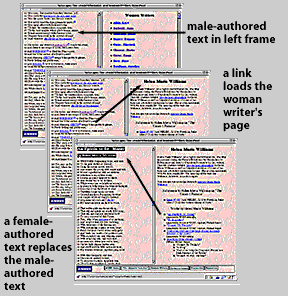2 One way of approaching WORP, then, is as an anthology of women writers. By finding, cataloging, digitizing and releasing works devoted to these women writers, the developers of the WORP project are questioning traditional Romantic canonicity by recovering works that have been out of circulation or ignored by scholars over the years. But this approach may be somewhat limited. For instance, it might be argued that the placement of "The Unsex'd Females" in the left-hand frame of the browser window reifies a male privileging which is at issue in debates about canonicity. The women writers are present in the opening browser window merely as an aggregate menu, a collection, while the male-authored and misogynistic text is first to meet the reader as her eye scans from left to right in the browser window. By virtue of the poem's position in the left-hand frame and the grouping of the women's works within submenus, the male aesthetic is privileged. So, although heavily weighted with women authors, the project offers what is in many ways a traditional path into the texts.
3 However, the design of the project problematizes the foregrounding of the Polwhele poem by creating an eventual intertextual dialogue between "The Unsex'd Females" and the women it critiques. A second possible approach for readers is to begin by exploring the text of "The Unsex'd Females."
The references to the women writers in the poem are linked. Clicking on the link brings the page devoted to that particular writer into the right-hand frame. Once a reader brings the page devoted to a woman writer into the right-hand frame and begins to explore its content, an interesting elision takes place.
 4 The image at the left shows a possible reading path through the WORP project. Activate an animated image to see how following a link to one of the works by the woman writer brings that text into the left-hand frame of the project. By replacing "The Unsex'd Females" in the left-hand frame with the woman's text, the project features the woman writer as it elides Polwhele's text. The hypertextual construction of WORP, then, doesn't attempt to obviate issues of privilege and status. In fact, it makes them more obvious by demonstrating privileging and elisions which are often discussed only in the abstract. Whether readers begin by exploring the pages devoted to women writers or whether they work through the text of "The Unsex'd Females," eventually the male-authored text will be replaced in the left-hand frame of the project.
4 The image at the left shows a possible reading path through the WORP project. Activate an animated image to see how following a link to one of the works by the woman writer brings that text into the left-hand frame of the project. By replacing "The Unsex'd Females" in the left-hand frame with the woman's text, the project features the woman writer as it elides Polwhele's text. The hypertextual construction of WORP, then, doesn't attempt to obviate issues of privilege and status. In fact, it makes them more obvious by demonstrating privileging and elisions which are often discussed only in the abstract. Whether readers begin by exploring the pages devoted to women writers or whether they work through the text of "The Unsex'd Females," eventually the male-authored text will be replaced in the left-hand frame of the project.
